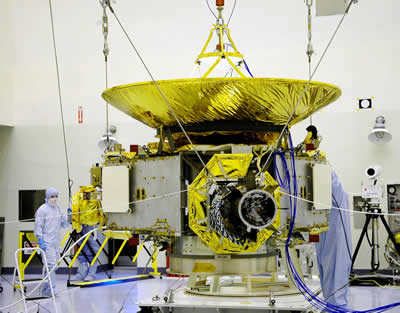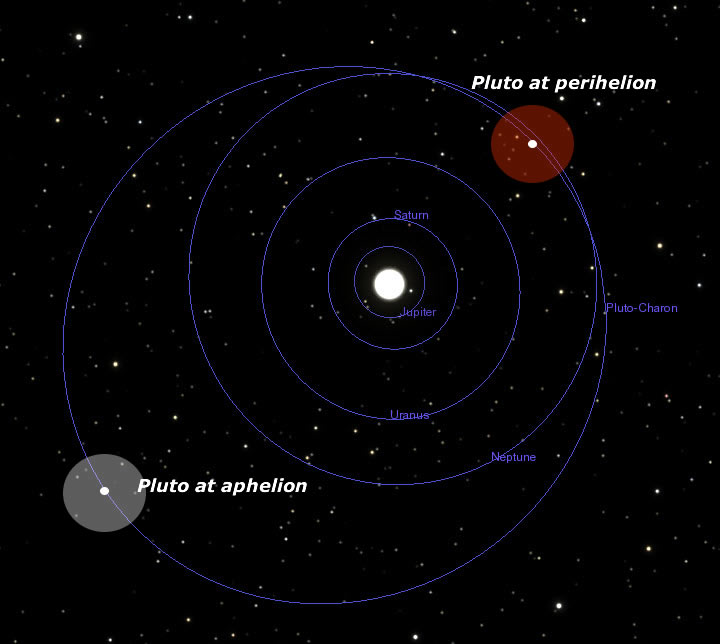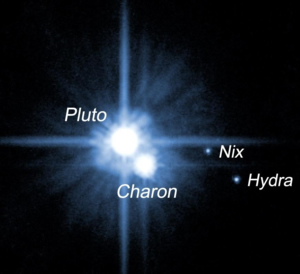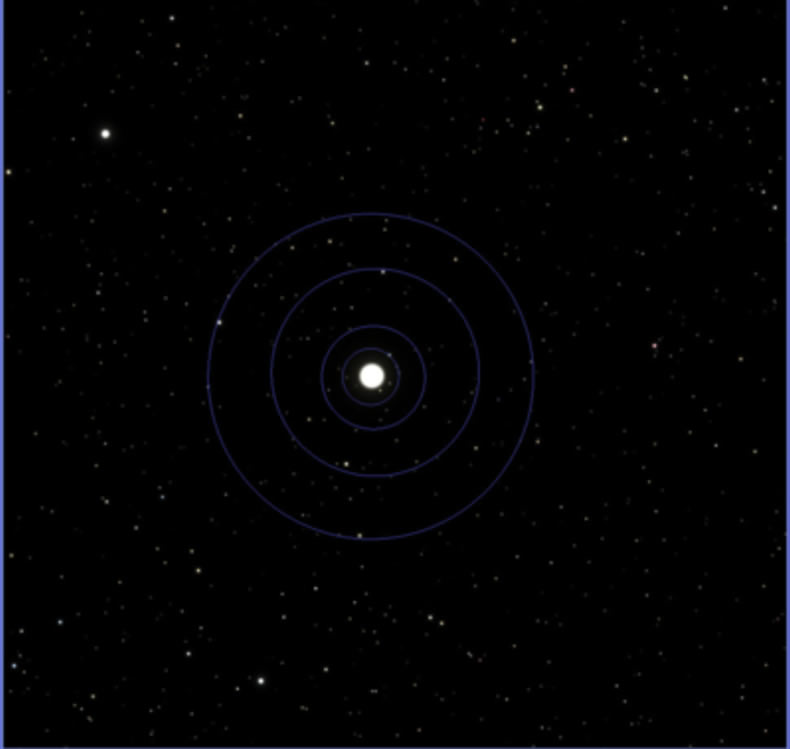Pluto and the Dwarf Planets
552-556
In August 2006 Pluto was demoted! As you will see, Pluto just doesn't "fit" in either the Terrestrial or Jovian planet classification and so, after many years of debate (at times heated!), the International Astronomical Union made the decision to classify Pluto as a Dwarf Planet and to provide a more precise definition of the term "planet".
Basic Facts
|
 |
||||||||||||||||||||||
| Figure 18.33a New Horizons true colour image of Pluto. (image courtesy NASA) | |||||||||||||||||||||||
New Horizons Reaches Pluto!
After more than a 9 year journey the New Horizons space craft reached Pluto in the summer of 2015 and send back stunning images of this distant world and its small retinue of moons. Figure 18.33b shows the space craft prior to launch in 2009.
New Horizons is providing us with remarkable data and is re-writing our understanding of Pluto and its moons. Figure 18.33 c,d show some of the remarkable images that New Horizons has sent back to earth. As these notes are being written our understanding of Pluto and its moons is rapidly evolving. Nasa maintains a fascinating web site providing updates on the research coming out of New Horizons. Go to https://www.nasa.gov/mission_pages/newhorizons/main/index.html |
 |
| Figure 18.33b New Horizons undergoing final tests prior to launch. (image courtesy NASA) | |
 |
 |
| Figure 18.33c A thin blue atmosphere scattering sunlight by nitrogen and methane crystals. (image courtesy NASA) | Figure 18.33b Glaciers of nitrogen "snow"!. (image courtesy NASA) |
The Interior and Atmosphere
Little detailed knowledge is available about either the interior structure or atmosphere of Pluto. Hubble observations suggest that the surface is composed of nitrogen and methane ices and rock. The density of Pluto suggests that it is roughly 35 % ices and 65% rocky material.
Pluto does have a very thin atmosphere and, because Pluto travels on such a highly elliptical orbit there is considerable difference between the solar heating at perihelion compared to aphelion. Figure 18.34 shows this. When Pluto is closest to the sun there is enough warmth to cause some of the nitrogen-methane crust material to vapourize and form a thin atmosphere. At aphelion this material freezes out as nitrogen-methane frost layer on the dwarf planet's surface.
 |
| Figure 18.34 Pluto's orbit showing the extremes between aphelion and perihelion. |
Pluto's Moons
| Pluto has three moons:Charon, Nix and Hydra as shown in Figure 18.35. By studying the orbit of Charon astronomers have been able to determine the mass of Pluto and Charon and determine that Charon's mass is about 1/12th the mass of Pluto. As well, because of the close proximity of these two bodies, tidal stretching and heating is probably happening. |  |
| Figure 18.35 Pluto and its moons as seen in this Hubble image. (Image courtesy HSTScI/NASA) |
Example 18.11 In what ways is Pluto unlike the major outer planets?
Solution: Pluto is much smaller than the outer planets and does not have a thick hydrogen and helium atmosphere. As well, it is a very slow rotator and is denser than the Jovian planets.
What is a "Planet"?
SIze matters! The International Astronomical Union have adopted the following criteria for full planet status:
the object must be massive enough so that its self-gravitation will cause it to form a spherical shape |
|---|
| the object must be massive enough to clear its orbit of any remaining debris. |
Pluto meets only the first of these criteria and for that reason has been re-classified as a dwarf-planet.
Plutinos and the Kuiper Belt Objects
In the early history of the solar system the icy planetesimals that were not incorporated into newly forming planets were likely forced out of the inner solar system through gravitational interactions with the planets. Astronomers think that many of these planetesimals are contained in the vast Oort cloud - a spherical distribution of cometary material that lies about 50 000 AU from the Sun. Closer in is a smaller region of very old planetesimal material - the Kuiper Belt. We now believe that Pluto is really a Kuiper Belt Object (KBO). There could be in excess of 100 million KBOs measuring a km or bigger in the Kuiper Belt. Since 1992 more than 1000 KBOs in orbits beyond Neptune have been discovered. In addition to Pluto other major KBOs are Sedna, Eris, Quaoar and Orcus.
Among the known KBOs is a subset which includes Pluto and which all exhibit a 3:2 orbital resonance with the planet Neptune. These objects are known as plutinos. Why these objects are in a resonance with Neptune is still not well understood but it may be related to how Neptune formed. There is evidence supporting the idea that both Uranus and Neptune formed closer to the Sun and migrated outward later in the history of the solar system. The plutinos may have become entrained with Neptune as this happened.
Example 18.12 Show that Pluto and Neptune are in a 3:2 resonance
Solution: A 3:2 resonance means that Neptune will complete 3 orbits around the Sun for every 2 completed by Pluto. Neptune's orbital period is 164.8 a; Pluto's orbital period = 248.1 a; so

which is close enough to be considered a resonance.
Practice
- Shown below is a roll-over image of the Jovian planet orbits and some of the more prominent KBOs. What significant feature is different for the KBO orbits and explain why this suggests that KBOs (including Pluto) are different than the planets. (Place mouse over image to see KBOs orbits superimposed on Jovian orbits)
 |
|
|

To understand Pluto as a Dwarf Planet
Chp 24-3

Pluto was discovered in 1930 by the young amateur astronomer Clyde Tombaugh. Even in the largest ground based telescopes Pluto is a faint object.
.